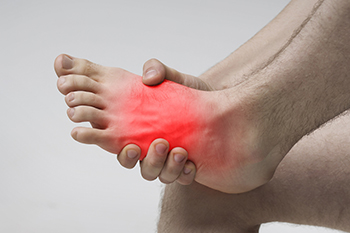Blog
Items filtered by date: October 2025
Causes and Symptoms of Peroneal Tendonitis

Peroneal tendinitis occurs when the tendons running along the outer ankle become inflamed or weakened due to overuse, repetitive strain, or injury. These tendons, which connect the peroneal muscles to the bones of the foot, help stabilize the ankle, point the foot downward, and turn it outward. People with high arches, a history of ankle sprains, or those who frequently engage in running or sports involving quick pivoting are at a higher risk. Symptoms include gradual pain on the outer ankle that worsens with activity, stiffness in the morning, and discomfort when the foot is turned inward. A podiatrist can diagnose peroneal tendinitis through an examination and imaging, and provide treatment to reduce inflammation, correct abnormal foot mechanics, and restore tendon strength. In more severe cases, immobilization or surgery may be required if the tendon has significant tearing. If you have symptoms of peroneal tendinitis, it is suggested that you schedule an appointment with a podiatrist for an exam and appropriate treatment.
Ankle pain can be caused by a number of problems and may be potentially serious. If you have ankle pain, consult with one of our podiatrists from South Jersey Foot & Ankle Institute. Our doctors will assess your condition and provide you with quality foot and ankle treatment.
Ankle pain is any condition that causes pain in the ankle. Due to the fact that the ankle consists of tendons, muscles, bones, and ligaments, ankle pain can come from a number of different conditions.
Causes
The most common causes of ankle pain include:
- Types of arthritis (rheumatoid, osteoarthritis, and gout)
- Ankle sprains
- Broken ankles
- Achilles tendonitis
- Achilles tendon rupture
- Stress fractures
- Bursitis
- Tarsal tunnel syndrome
- Plantar fasciitis
Symptoms
Symptoms of ankle injury vary based upon the condition. Pain may include general pain and discomfort, swelling, aching, redness, bruising, burning or stabbing sensations, and/or loss of sensation.
Diagnosis
Due to the wide variety of potential causes of ankle pain, podiatrists will utilize a number of different methods to properly diagnose ankle pain. This can include asking for personal and family medical histories and of any recent injuries. Further diagnosis may include sensation tests, a physical examination, and potentially x-rays or other imaging tests.
Treatment
Just as the range of causes varies widely, so do treatments. Some more common treatments are rest, ice packs, keeping pressure off the foot, orthotics and braces, medication for inflammation and pain, and surgery.
If you have any questions please feel free to contact our office located in Mullica Hill, NJ . We offer the newest diagnostic tools and technology to treat your foot and ankle needs.
How the Foot and Ankle Work Together in Dance

The foot and ankle bones work in harmony to create balance, stability, and graceful movement while dancing. Each step involves coordinated motion through stages of flexion, extension, and rotation supported by muscles and tendons that control strength and precision. Dancers rely heavily on these structures, making them prone to injuries such as sprains, tendonitis, and stress fractures from repetitive strain or overuse. Proper foot alignment and strength are essential for safe and fluid motion. A podiatrist can assess foot mechanics, treat injuries, and recommend exercises or custom orthotics to enhance performance and prevent future issues. If pain or instability is affecting your dance practice, it is suggested that you consult a podiatrist who can treat various foot conditions, and guide you on effective dance injury prevention tips.
If you have any concerns about your feet, contact one of our podiatrists from South Jersey Foot & Ankle Institute. Our doctors can provide the care you need to keep you pain-free and on your feet.
Biomechanics in Podiatry
Podiatric biomechanics is a particular sector of specialty podiatry with licensed practitioners who are trained to diagnose and treat conditions affecting the foot, ankle and lower leg. Biomechanics deals with the forces that act against the body, causing an interference with the biological structures. It focuses on the movement of the ankle, the foot and the forces that interact with them.
A History of Biomechanics
- Biomechanics dates back to the BC era in Egypt where evidence of professional foot care has been recorded.
- In 1974, biomechanics gained a higher profile from the studies of Merton Root, who claimed that by changing or controlling the forces between the ankle and the foot, corrections or conditions could be implemented to gain strength and coordination in the area.
Modern technological improvements are based on past theories and therapeutic processes that provide a better understanding of podiatric concepts for biomechanics. Computers can provide accurate information about the forces and patterns of the feet and lower legs.
Understanding biomechanics of the feet can help improve and eliminate pain, stopping further stress to the foot.
If you have any questions please feel free to contact our office located in Mullica Hill, NJ . We offer the newest diagnostic and treatment technologies for all your foot and ankle needs.
Pain on the Top of the Foot

Extensor tendinopathy is a condition that affects the tendons on the top of the foot, which help lift the toes and stabilize the foot while walking or running. When these tendons become irritated or overworked, they can cause pain and swelling across the top of the foot or around the ankle. The discomfort often worsens with activity, especially when running uphill, climbing stairs, or wearing tight shoes that put pressure on the tendons. This condition can develop from overuse, sudden increases in exercise, wearing poor footwear, or foot structures that place extra strain on the tendons. Rest, supportive shoes, and targeted stretching exercises may ease symptoms, while more persistent cases might benefit from orthotics, or other targeted treatments. If pain on the top of your foot is interfering with daily life or activity, it is suggested that you see a podiatrist for diagnosis and a treatment plan that supports relief and healing.
Foot Pain
Foot pain can be extremely painful and debilitating. If you have a foot pain, consult with one of our podiatrists from South Jersey Foot & Ankle Institute. Our doctors will assess your condition and provide you with quality foot and ankle treatment.
Causes
Foot pain is a very broad condition that could be caused by one or more ailments. The most common include:
- Bunions
- Hammertoes
- Plantar Fasciitis
- Bone Spurs
- Corns
- Tarsal Tunnel Syndrome
- Ingrown Toenails
- Arthritis (such as Gout, Rheumatoid, and Osteoarthritis)
- Flat Feet
- Injury (from stress fractures, broken toe, foot, ankle, Achilles tendon ruptures, and sprains)
- And more
Diagnosis
To figure out the cause of foot pain, podiatrists utilize several different methods. This can range from simple visual inspections and sensation tests to X-rays and MRI scans. Prior medical history, family medical history, and any recent physical traumatic events will all be taken into consideration for a proper diagnosis.
Treatment
Treatment depends upon the cause of the foot pain. Whether it is resting, staying off the foot, or having surgery; podiatrists have a number of treatment options available for foot pain.
If you have any questions, please feel free to contact our office located in Mullica Hill, NJ . We offer the newest diagnostic and treatment technologies for all your foot care needs.
Reminder: When Was the Last Time...?
What Your Feet Can Expect When You Are Expecting
 Pregnancy can affect the body in a variety of ways. Weight gain, hormonal changes, and increased bodily fluids during pregnancy can all have negative effects on your feet and ankles. A loosening of joints and ligaments can also lead to flat feet, bunions, and ankle instability exacerbated by weight gain—which can also cause the feet to swell and widen. Blood flow irregularities can also produce cramping, swelling and pain in the feet and calves. While many of these adverse effects will subside post-pregnancy, some conditions can remain problematic. If you are struggling with these issues, you should consult with a podiatrist.
Pregnancy can affect the body in a variety of ways. Weight gain, hormonal changes, and increased bodily fluids during pregnancy can all have negative effects on your feet and ankles. A loosening of joints and ligaments can also lead to flat feet, bunions, and ankle instability exacerbated by weight gain—which can also cause the feet to swell and widen. Blood flow irregularities can also produce cramping, swelling and pain in the feet and calves. While many of these adverse effects will subside post-pregnancy, some conditions can remain problematic. If you are struggling with these issues, you should consult with a podiatrist.
Pregnant women with swollen feet can be treated with a variety of different methods that are readily available. For more information about other cures for swollen feet during pregnancy, consult with one of our podiatrists from South Jersey Foot & Ankle Institute. Our doctors will attend to all of your foot and ankle needs.
What Foot Problems Can Arise During Pregnancy?
One problem that can occur is overpronation, which occurs when the arch of the foot flattens and tends to roll inward. This can cause pain and discomfort in your heels while you’re walking or even just standing up, trying to support your baby.
Another problem is edema, or swelling in the extremities. This often affects the feet during pregnancy but tends to occur in the later stages.
How Can I Keep My Feet Healthy During Pregnancy?
- Wearing orthotics can provide extra support for the feet and help distribute weight evenly
- Minimize the amount of time spent walking barefoot
- Wear shoes with good arch support
- Wear shoes that allow for good circulation to the feet
- Elevate feet if you experience swelling
- Massage your feet
- Get regular, light exercise, such as walking, to promote blood circulation to the feet
If you have any questions, please feel free to contact our office located in Mullica Hill, NJ . We offer the newest diagnostic and treatment technologies for all your foot care needs.


